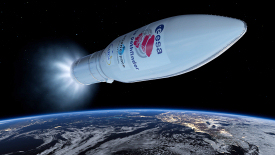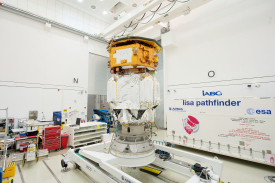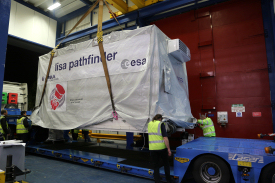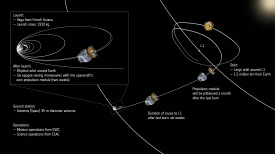LISA Pathfinder arrives at launch site
8 October 2015
LISA Pathfinder, ESA's demonstrator for space-based observations of gravitational waves, has arrived at Europe's spaceport in Kourou, French Guiana, ahead of a launch currently foreseen for 2 December.
 |
| LISA Pathfinder launch. Credit: ESA/ATG medialab |
Once operating in space, LISA Pathfinder will pave the way for future missions by testing critical concepts and technologies related to the detection of gravitational waves, ripples in spacetime, the very fabric of the Universe. To do so, it will put two small gold-platinum cubes in a near-perfect gravitational free-fall through space, and control and measure their motions with unprecedented accuracy.
LISA Pathfinder consists of a science module, containing the core elements of the science experiment, that will be transferred by a separable propulsion module to its operational Lissajous orbit around the Lagrange point L1, 1.5 million kilometres away from Earth in the direction of the Sun.
Since early September, following completion of the final integration and test campaign at IABG in Ottobrunn, Germany, LISA Pathfinder has been at the Stevenage, UK, premises of prime contractor Airbus Defence and Space, awaiting transport to the launch site.
The spacecraft departed from London Stansted Airport last night, in an environmentally controlled container onboard an Antonov An-124 cargo aircraft, and arrived at Cayenne Félix Eboué Airport, French Guiana, in the early hours of this morning.
 |
 |
|
| LISA Pathfinder launch composite at IABG's test centre. Credit: ESA–P. Sebirot, 2015 | LISA Pathfinder leaving Airbus Defence and Space. Credit: Airbus Defence and Space |
In addition to the science and propulsion modules, the Antonov also transported specialised support equipment, to be used at the launch site as the spacecraft is readied for lift-off.
Once on the ground at Cayenne, the spacecraft and equipment were transported in a convoy to the Centre Spatial Guyanais site where the cleanrooms and preparation facilities are located.
 |
| Journey to L1. Credit: ESA/ATG medialab |
For the next eight weeks, teams from ESA and Airbus Defence and Space will be busy preparing the spacecraft for launch on Arianespace flight VV06 – the sixth launch of Europe's small Vega launcher – currently scheduled for 2 December at 04:15:00 UTC.
After ascent on the Vega, the spacecraft will enter an elliptical orbit around Earth, where it will use its own propulsion system to raise the high point of its orbit.
Eventually, after about two months, LISA Pathfinder will reach its operational orbit around L1. Once there, it will begin six months of scientific and technical operations, demonstrating the technology for future gravitational-wave observatories in space.
About LISA Pathfinder
LISA Pathfinder will test the technology required to detect gravitational waves in the range of 0.0001–0.1 Hz, paving the way for future gravitational-wave observatories in space.
At the core of LISA Pathfinder are two individual freely-falling test masses. These are cubes of gold-platinum alloy measuring 46mm on a side and weighing 1.96 kg, separated by 38 cm. A complex laser system monitors the distance between them to the level of roughly 1 picometre, or 10–12 m.
The two test masses are surrounded but not touched by the spacecraft. Its job is to shield the masses from all outside influences such as the solar wind so that they can fall under gravity’s influence alone, and it constantly applies tiny adjustments to its position to avoid making contact with them.
This will allow scientists to demonstrate whether it is possible to put two test masses into a near-perfect gravitational free-fall – the most challenging requirement for detecting gravitational waves.
Gravitational waves are tiny ripples in the fabric of spacetime caused by the motion of massive objects. LISA Pathfinder is not aimed at the detection of gravitational waves themselves, but rather its goal is to prove the innovative technologies needed to reduce external influences on two test masses and to measure their relative motion with unprecedented accuracy, tracking their free-fall by more than two orders of magnitude better than any past, present or planned mission.
In a full-scale gravitational-wave observatory, the test masses would be housed in two individual spacecraft separated by about a million km: on this scale, gravitational waves generated by objects such as merging black holes anywhere in the Universe would change the distance between the cubes at the level of picometres and would thus become measurable.
LISA Pathfinder will be operated from the European Space Operations Centre in Darmstadt, Germany, using ESA's tracking station network, ESTRACK, throughout the mission duration. During science operations, the 35-m antenna at Cebreros, Spain, will be used for communicating with the spacecraft.
The designation 'LISA' in the mission's name stands for Laser Interferometer Space Antenna, an earlier concept for a space-based observatory for gravitational waves, and now used to describe a class of missions based on the original LISA concept.
LISA Pathfinder is an ESA mission, and will also carry a separate NASA payload.






